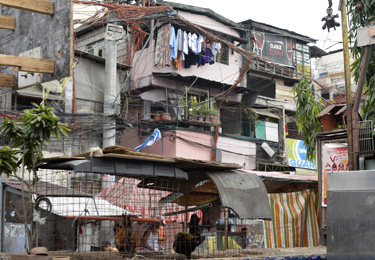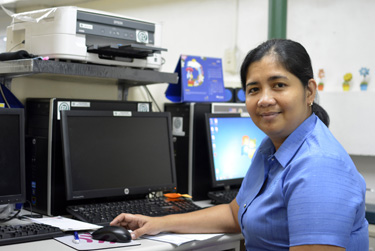(只有英文)远离伤害:应对菲律宾网络性虐待儿童问题
2016-06-03
(只提供英文版本)
As stated by the United Nations Convention on the Rights of the Child, there are no circumstances in which using children in pornographic performances and materials is acceptable. “‘Child pornography’ is a misnomer – the phrase implies that the sexual exploitation of children is subset of a (mostly) legal industry,” says Chief of Child Protection at UNICEF Philippines Sarah Norton-Staal. “Any children under the age of 18 who are used for pornographic performances or materials are victims. Any image or video of child abuse is documented evidence of a crime in process. The production and distribution of these child sexual abuse and exploitation materials – whether in print, online, or live-streamed – represent a violation of fundamental human rights, and these children need to be protected.”By Andy Brown
The Philippines has become the global epicentre of the live-stream sexual abuse trade, and many of the victims are children. In the slums of Manila, a police raid of a child sexual exploitation operation illuminates the challenges the country faces in protecting vulnerable children and prosecuting their abusers.

© UNICEF Philippines/2016/Brown Rescued children in the playroom at the Child Protection Unit at the Philippine General Hospital. After the police raid, the children were ought here by a social worker and then examined by a paediatrician.
MANILA, Philippines, 3 June 2016 – One evening in 2014, Philippines police raided an ordinary looking home in the slums of Manila. It was just before midnight, and darkness permeated the surrounding narrow alleys as the officers entered with a search warrant. Inside the small single room house, they found an unusual amount of computer equipment: laptops, webcams and a Wi-Fi router.
They also found a group of four girls and boys aged between 7 and 10 preparing for a ‘show’. The children were about to undress and perform sex acts on each other, following instructions from a paedophile connected from overseas via webcam.
Live-stream child sexual abuse, also known as webcam sex tourism, was organized by an ‘operator’ living in the house, who was also the mother of one of the children. It was an ongoing, illegal business. Foreign perpetrators would send her money by international wire transfer, and she would pay children 150 pesos (HK$23.4/US$3).
The other three children were also living with the operator while their mother worked outside Manila. They called her ‘Auntie’ although she was not a blood relative. One of these children, 7-year-old Danilo*, told his father about the abuse, and he called the police. During the raid, the police seized the laptops as evidence and arrested the operator. The children were rescued by a social worker and ought to the Child Protection Unit at Philippine General Hospital in Manila. Here, they were examined by a paediatrician, Dr. Merle Tan. The centre had been recently renovated and provided a ight and cheerful environment for children, with a well-equipped playroom and therapy rooms. One of the children was 9-year-old Jennifer*, daughter of the operator. At first she denied anything had happened in order to protect her mother, who had told her what to say if the police came. But over the course of several therapy sessions, she slowly opened up to Dr. Tan and other staff at the centre.
Fuelled by poverty
Poverty is a key driving factor behind the international trade in live-stream child sexual abuse. Around one in three people in Manila live in slums, where makeshift houses made of wood, metal sheets and cardboard are often piled three or four storeys high alongside rivers and rubbish dumps. Many parents living here are unemployed or have unstable work, such as casual manual labour. Children play in the streets, and alcohol and drug abuse are rife. These areas are prime targets for criminal activity.
In the Manila slum where Jennifer and Danilo lived, it was an open secret that live-stream sexual abuse was happening. “The operator ran an open house, with ‘shows’ every other night,” Dr. Tan recalls. “If children in the slum were hungry, they knew they could come for food and shelter, plus 150 pesos(HK$23.4) for taking part in the ‘show’.”

© UNICEF Philippines/2016/Brown A slum area in Manila, similar to where the abuse happened. Poverty is a key driving factor behind the international trade in live-stream child sexual abuse.
In the Manila slum where Jennifer and Danilo lived, it was an open secret that live-stream sexual abuse was happening. “The operator ran an open house, with ‘shows’ every other night,” Dr. Tan recalls. “If children in the slum were hungry, they knew they could come for food and shelter, plus 150 pesos(HK$23.4) for taking part in the ‘show’.”
Shockingly, some parents even ought their own children to the house. “People tell themselves it’s not abuse, because the perpetrator isn’t touching the children,” Dr. Tan says. “But the children are still being abused, and this harms their mental and physical development. As they grow up, they may have problems forming relationships, and can get further drawn into sex work, or even become abusers themselves.”
The Philippines has become the global epicentre of the live-stream sexual abuse trade. In some parts of the country, such as Mactan Island in Cebu, there are ‘hotspots’ where both webcam pornography involving adults and live-stream child sexual abuse are widespread in a village or local community. These areas have been the focus of arrests and interventions.

© UNICEF Philippines/2016/Brown One of the therapy rooms at the Child Protection Network, where Jennifer was interviewed. Over the course of several therapy sessions, Jennifer was able to open up about what happened to her.
UNICEF Philippines is conducting research on the issue, funding training for police and NGOs, helping to establish a national helpline, and advocating for stronger national policies.
“This has been going on a few years now, but we’re seeing more and more cases,” says Sarah Norton-Staal, Chief of Child Protection at UNICEF Philippines. “Increased Internet access and cheaper devices have ought poor communities online. The standard of English is very high and child sex offenders have been visiting since the 1970s. There’s a large Filipino diaspora that regularly sends money home from aoad. And there’s a culture of silence and deference to elders, which keeps abuse hidden. All of this contributes to creating an easy environment for criminals.”
In 2009, following advocacy by UNICEF and others, child sexual abuse materials were made illegal in the Philippines for the first time. But more needs to be done. “The legal age of sexual consent in the Philippines is still just 12 years old,” says Ms. Norton-Staal. “This makes it harder to convict people for child sexual abuse. We want to see this raised to at least 16 years, along with greater resources for finding and convicting offenders.”
Holistic response
At the Philippines Department of Justice, Assistant Secretary Monica Pagunsan says the government is taking a comprehensive approach to the issue. “The Philippines is said to be the top source of ‘child pornography’ globally,” she says. “The passage of an Anti-Child Pornography Law and creation of the Office of Cybercrime gave impetus to the campaign against online child sexual abuse. We have extradition treaties with at least 13 countries and work closely with Interpol.”
However, despite these efforts, conviction rates remain low. Ms. Pagunsan highlights the need for greater cooperation with the private sector. “The government cannot do this alone,” she says. “We need help from the private sector, especially the telecom companies and Internet service providers. We’re concerned about the length of time it takes to remove content, identify victims and perpetrators, and preserve evidence.”
“At the moment, we need to go get a court order before the companies will cooperate with an investigation,” she continues. “By that point, the abuser has often disappeared.”
At the Philippines National Police headquarters, Colonel Ivy Castillo heads up the new cybercrime unit, which includes live-stream child sexual abuse. It’s a small unit in a tiny cabin on the sprawling campus. Ivy reports that the number of cases are rising, from 57 in 2013 to 89 in 2014 and 167 in 2015. However, so far there have been only seven convictions, all of them under child trafficking legislation.

© UNICEF Philippines/2016/Brown Colonel Ivy Castillo the Philippines National Police. Col. Castillo leads the new cybercrime unit, which covers live-stream child sexual abuse.
“Most of our leads come from our overseas police counterparts,” Col. Castillo says. “They find images from the Philippines on suspects’ computers, and ask us to trace them. Or they take over a perpetrator’s Facebook account and use it to contact the operators.” However, the unit gets very few local leads. “Filipinos are reluctant to report abuse or file complaints,” she continues. “Some people don’t know that it’s wrong, or are unaware of the penalties.”
To tackle this issue, the unit conducts awareness-raising activities in schools and communities, especially in ‘hotspot’ areas where abuse is rife. UNICEF is funding training for police officers on how to identify and deal with cybercrime. But, so far, the criminals remain a step ahead.
For people working on the frontline of live-stream child sexual abuse, like Dr. Tan at the Child Protection Unit, it can sometimes feel like an uphill struggle. “It can be really depressing but I have to stay strong,” Dr. Tan says. “I try to put all of the sad thoughts out of my mind. I don’t want these stories to affect me. I have to stay strong and positive in order to help our children.”
*Names have been changed to protect the victims’ identities.









